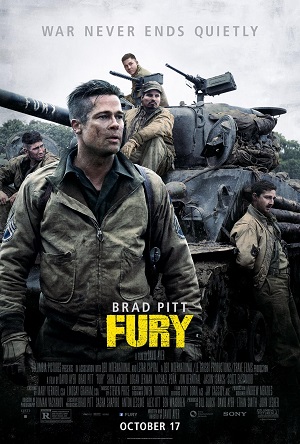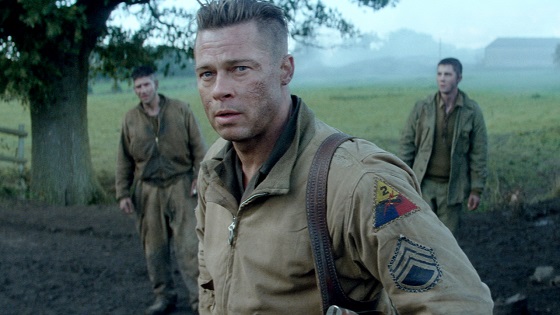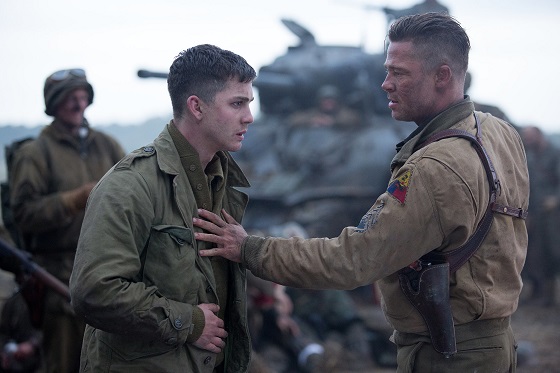Rating: Rock Fist Way Up
I recall a conversation I had over lunch one day with our Editor-In-Chief Eric Melin a few months back about Alfonso Cuaron’s film Gravity, and how when he saw it the second time he was able to ignore all the visuals and focus on the journey of Sandra Bullock’s character. I had a similar feeling while I was watching David Ayer‘s newest film Fury. I knew that, as I was experiencing the film, I was missing something, despite enjoying what I saw. For some odd reason that months-old conversation popped into my mind and I realized why I liked the film so damn much.
Don “Wardaddy” Collier (Brad Pitt, perhaps re-channeling Lt. Aldo Raine from Inglorious Basterds) leads a gritty crew of tankers in their M4A2E8 Sherman tank with the word “FURY” lovingly painted on the barrel of the main gun. After their assistant driver is killed in action, a scared-shitless kid, Norman Ellison (Logan Lerman) is given orders to report to FURY and take his place. Of course, the new guy has to pay his dues and get dogged on by the veterans of the tank (played by Shia LaBeouf, Jon Bernthal, and Michael Pena). Pitt has made his crew a promise to keep them alive to the end of the war, and by not training the greenhorn (who was trained as a typist, not a tanker!), Pitt would be endangering the lives of his crew. So Norman learns the harsh realities of war and bonds with his tank crew, but nothing can prepare him for a last stand defending a crossroads in Germany against hundreds of SS soldiers headed straight for a battalion of American medics and mechanics. The crew of FURY must hold the line.
So now that you’ve got an idea of where this film is coming from, I can begin to (hopefully) articulate what hit me so hard about this film.
Shia LaBeouf is a guy who’s taken a lot of flak in recent years, being the center of some pretty public meltdowns and for starring in things like Transformers, but it bears mentioning he was fantastic in Fury. His character is the religious, moral center of the tanker crew, encouraging them to pray together, quoting scripture at people whenever the opportunity presents itself, and yet also being able to swear, drink, and kill with the best of ’em. There’s a hollow look in his eyes and a genuineness that LaBeouf brings to Boyd “Bible” Swan that I’m not sure anyone else could’ve done half as well.
The performance that really sold the film though, was Logan Lerman in the leading role as Private Norman Ellison. The greenhorn-turned-war-vet shows how intense situations either make or break people very quickly, and nowhere was this more apparent than in the men and women of what we often refer to as the Greatest Generation, who struggled through the Great Depression and were forged into leaders by the fires of the second World War. Norman goes through all these steps, and Lerman’s performance really drives home the sink-or-swim necessity of war. Visually, we watch as Private Ellison goes from literally squeaky-clean typist to filthy, battle-hardened tanker in the span of (assumedly) a few days, and we see how his attitude reflects the gravity of his situation and changes over time. The dynamic arc of the film is really how Ellison’s personal journey as a part of the crew of FURY changes him in such a short time, not necessarily in the missions and events the crew experiences together.
The only real problem I had with the film is a very minor problem of an unclear time frame. The film opens and lets us know that it’s April 1945, but beyond that, I’m unsure what the time frame of the events of the film are supposed to be? A day? A few weeks? A month? Who knows. It’s a minor gripe, but it’s the one question I couldn’t get out of my head after exiting the theater.
From a technical standpoint, Fury–as with any WWII film–has the unwritten rule of a particular visual style, with the color spectrum skewed towards grey-greens and with reds standing out a bit more. It’s not quite black-and-white, but gives enough contrast in showing the dreary tone of war, and with more vibrant colors standing out in ways like a woman’s dress catching the eye of a soldier (a “bright” spot in a hopeless situation), or a particularly gory moment of combat–images that burn in our minds–these moments are made to stand out to our eyes immediately amidst a backdrop of grey-green nothingness. It’s an old trope to be sure, but it’s one that will never stop working when done correctly, because of the way it shows us just how hellish things can get.
While the story of Fury is indeed fictional, its source material isn’t that far from the fantastical. There’s a handful of tanks and crews that survived the second world war intact, and in fact, the role of FURY itself was played by a genuine Sherman tank, and Fury marks the first time an actual German Tiger tank was used in a film since 1946. Indeed, even the exploits of the tanker crew are reminiscent of WWII’s most decorated soldier Audie Murphy’s Medal of Honor-earning stand atop a burning tank, firing a .50 caliber machine gun at the Germans, stopping only when his ammunition was fully expended, and getting wounded in the process.
Director/screenwriter Ayer with his eye for authenticity ensured his actors went through an intense boot camp ran by Navy SEALS, and had them actually live together in the tank to get in the mindset of their characters, as well as going to significant lengths to make sure all uniforms and weaponry were up to scratch and accurate to the end of the war.
With the timing of this film coming out just before Veterans’ Day, it’s important that we not forget the sacrifices that men like the crew of FURY made in order to preserve the freedoms we enjoy today, and not pass off a film like Fury as simply well-done entertainment faire or a drum-beating foray into easy points for patriotism and fodder for people shouting about “MURICA.” Fury walks the line between romanticizing arguably the most important war of the past century and making you appalled that anyone ever went through such an experience voluntarily in what we’ve come to call the last great American crusade against the forces of tyranny.








{ 1 comment }
You write this in your article. “While the story of Fury is indeed fictional, its source material isn’t that far from the fantastical. There’s a handful of tanks and crews that survived the second world war intact,…”
Where did you get this info from and what source material shows that a “handful of tanks and crews survived the war.” Attrition rates among Sherman tankers were among the highest in the ETO. I know of only one tank crew that did survive. I am very curious as to where you got this info and if you can provide a source or sources for this statement? Also, I think you should visit http://furyfactorfiction.blogspot.com/
Thanks,
Lou
Comments on this entry are closed.